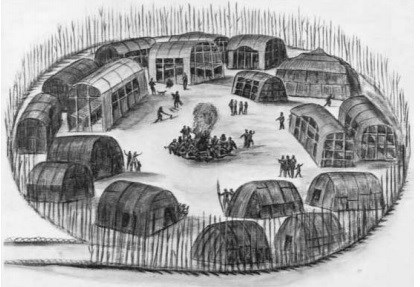Celebrate Native American Heritage Month- The Doeg and Manahoac Indian Tribes

Prince William, VA. – The Department of Parks, Recreation & Tourism celebrates the month of November as Native American Heritage Month. November marks a time to celebrate rich and diverse cultures, traditions, and histories and to acknowledge the important contributions of Native people.
Prince William County was not only home to two major tribes but was also a vital hunting ground and travel corridor for many surrounding, regional indigenous nations, including the Susquehanna to the north, Piscataway to the east, the Patawomeck and Rappahannock to the south, and the Iroquois to the west. The Potowomek, for whom the Potomac River was named, originated as an Algonquian-speaking nation member of the original Powhatan Confederacy/Chiefdom.
In the eastern part of Prince William County, the Doegs (sometimes called the Tauxenent, Taux or Toags) a tribe of the Algonquian Federation. The Doegs’ main village was on the north bank of the Occoquan River, had a structured society, living in villages and, although they hunted and fished, planted crops of maize (corn), pumpkins, sunflowers, squash, beans and tobacco in fields adjacent to their villages. Long gone now, the Doeg culture is found in present day place names: Occoquan, “at the end of the water”; Quantico, “by the long stream”; and Marumsco, “at the island rock.”
In the western part of the area could be found the Manahoac, understood by early explorers to mean "they were very merry.” A lesser-known indigenous group, the Manahoac, were part of a Siouan-speaking population that made the Northern Piedmont woodlands and Appalachian foothills. Thought to be semi-nomadic, the Manahoac were reported by John Smith to live in a few villages and to be allied with and share cultural ties to central Virginia’s tribes. Like most Virginia Native Americans, they supplemented their diet with crops of corn and squash, but the Piedmont Indians had learned to burn the forest to create grassland and attract deer and buffalo, their chief sources of food.
The arrival of the settlers in this area proved to be a disaster for the native Indians. Decimated by the Europeans' diseases for which they had no resistance and overwhelmed by the settlers' firepower in battle, they were soon driven away. By 1714, the remnants of the tribe were located on the upper Mattaponi River, but none survived until modern times.
The Manahoac had much less contact with the settlers, since they occupied land in the area beyond, and buffered by, the Doegs, the Manahoac found themselves dispossessed. As they moved westward, they come under attack by the warlike Iroquois, and the few who survived were later found in the vicinity of Lynchburg, but had disappeared from Virginia by 1753.
On July 2, 2015, the Bureau of Indian Affairs (BIA) officially recognized the Pamunkey Indian Tribe, the first Indian tribe in the Commonwealth of Virginia to be federally recognized.
To learn more about the Pamunkey Indian Tribe, visit the Pamunkey Museum & Cultural Center, and the National Congress of American Indians.
To learn more about the history of Prince William County, visit PWC Historic Preservation